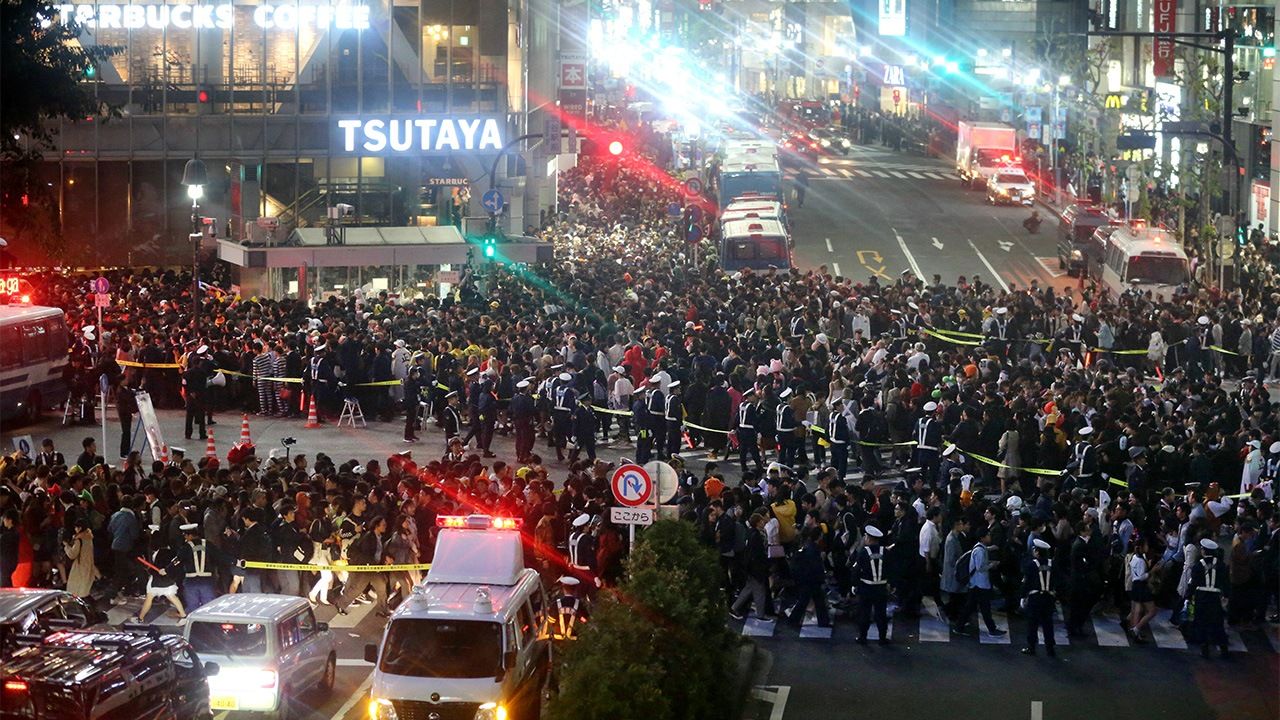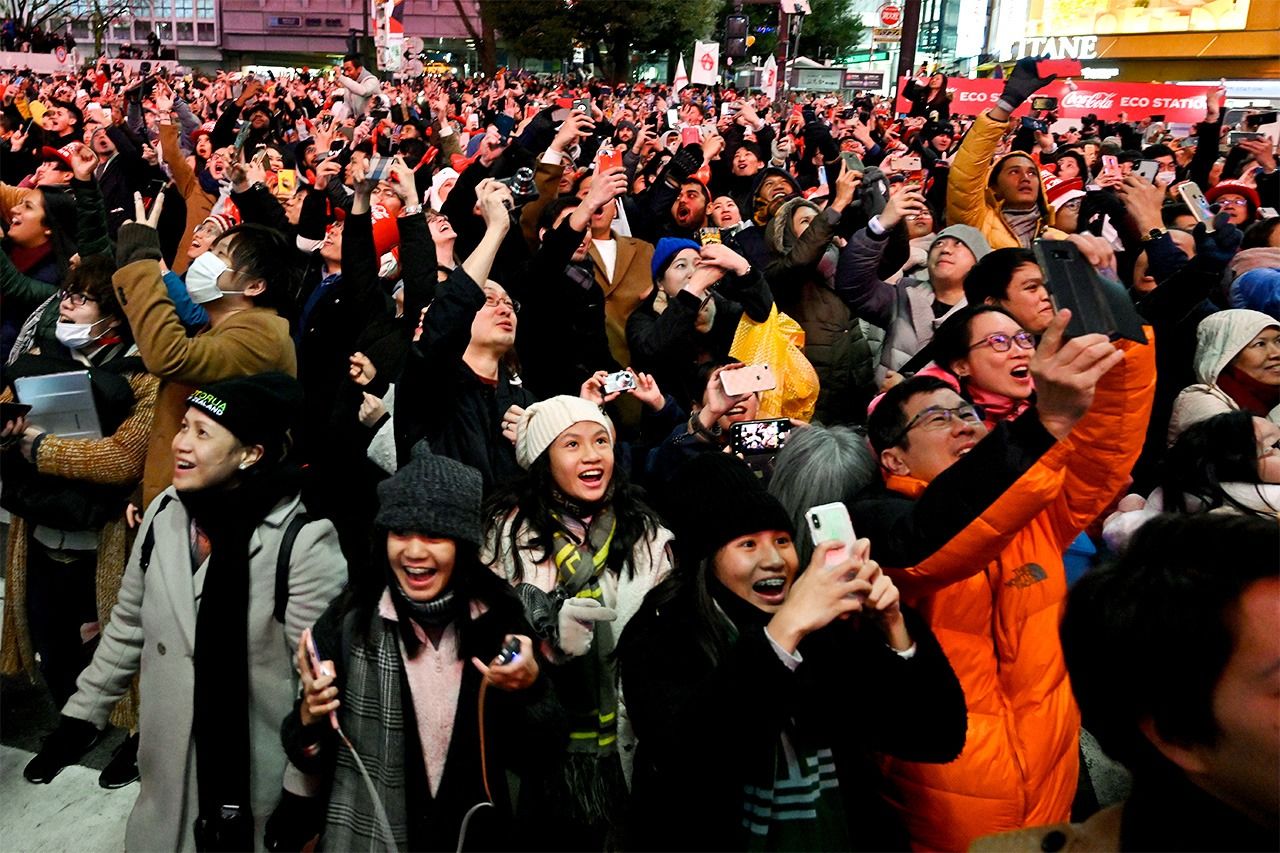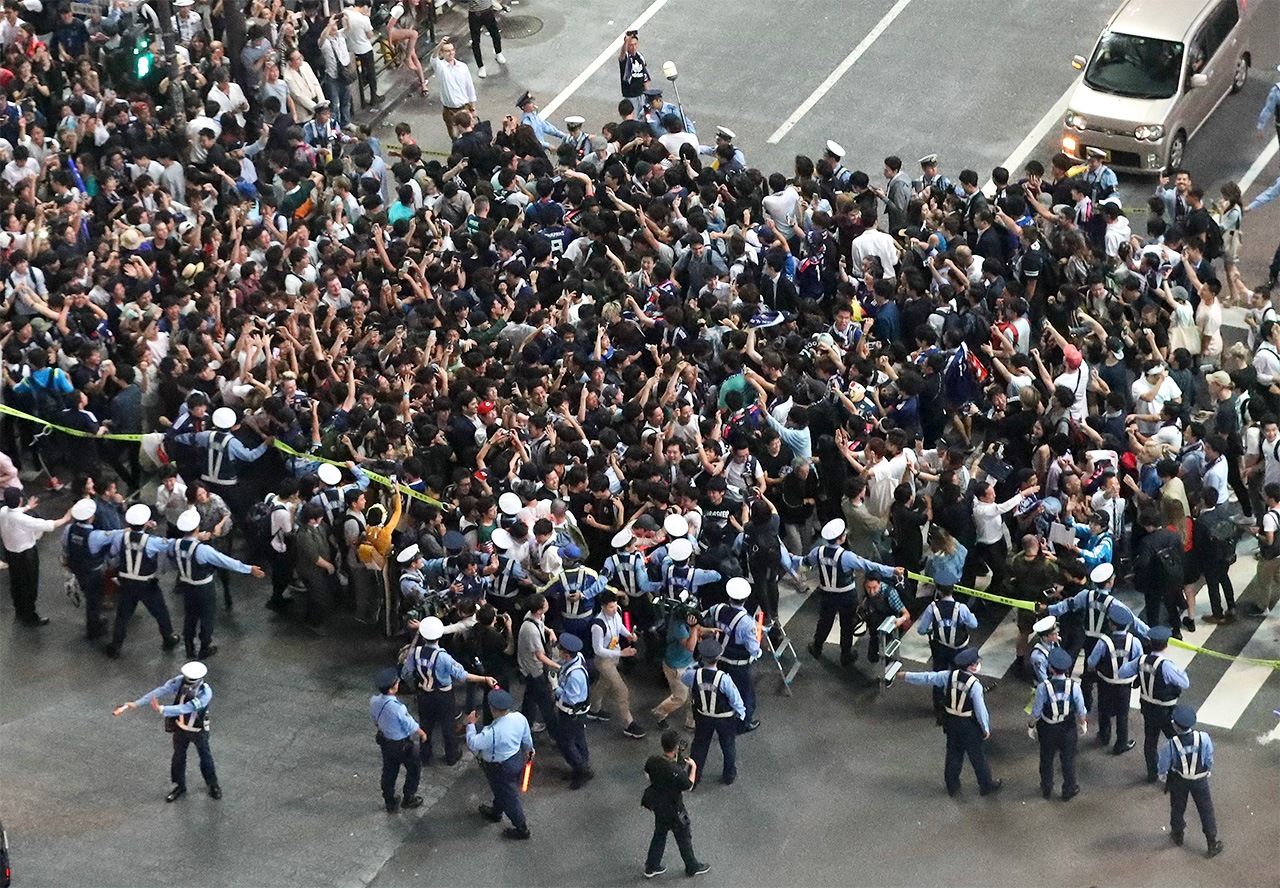
Untamed Tokyo: Shibuya at the Crossroads
Society- English
- 日本語
- 简体字
- 繁體字
- Français
- Español
- العربية
- Русский
Halloween Volatility
On October 31, 2017, police mobilized at the famed scramble crossing beside Shibuya Station in response to pandemonium that ensued the year before when unexpected numbers of costumed young people descended on the site. While Halloween crowds are nothing new in Kawasaki, Roppongi, or even at Tokyo Disneyland, it was not until 2015 that Shibuya found itself at the center of the holiday. Since then, the crowds, and subsequent police presence, have only increased.
Despite tightened security in the runup to Halloween 2018, rowdy revelers tipped a parked truck on its side and four men in their twenties were arrested on charges of collective property damage; a further 11 individuals, including nationals of France, Britain, and Belgium, had their cases referred to the public prosecutor. As a deterrent to further trouble, on October 30 a total of 800 police, spaced a few meters apart, surrounded the crossing.
Beacon of the Times
Located outside Shibuya Station’s Hachikō exit, the scramble crossing bustles day and night with overseas tourists and young people. It is one of the world’s busiest pedestrian crossing, used by up to 500,000 people per day and as many as 3,000 at once. While such crossings are relatively uncommon, similar types that allow pedestrians to travel in all directions at once can be found in some major cities around the world. The diagonal crossing in London’s Oxford Circus was even inspired by the one in Shibuya. While pedestrian areas like New York’s Times Square and the Champs Elysees in Paris enjoy international renown, it strikes me that the Shibuya scramble crossing enjoys the recognition that it does because it represents a modern incarnation of the ancient idea of topos, or place.
Shibuya’s international fame is a relatively recent development dating from the 1964 Tokyo Olympics. The games transformed the face of Shibuya: architecturally impressive structures like the Yoyogi National Gymnasium went up, the former Washington Heights US military housing area became the Olympic Village, and national broadcaster NHK relocated from across town. This was also the time that the Shuto Expressway and major thoroughfares including Aoyama-dōri and Roppongi-dōri opened.
Shibuya underwent further redevelopment during Japan’s period of rapid economic growth, and by the late 1970s it began to evolve a distinct voguish sense of space. The Parco building, a hub of fashion and youth culture, opened in 1973. Soon after, the gently inclined road leading toward Yoyogi Park on which Parco is situated was given the eloquent sounding name Shibuya Kōen-dōri, or ”Shibuya parkway.” Shibuya Public Hall and the small theater Shibuya Jean-Jean further boosted the street’s fashionable reputation. Then in 1979, the opening of iconic fashion mall Shibuya 109 turned Shibuya into a source of the latest youth fads.
Since the burst of Japan’s economic bubble in the 1990s, Shibuya has been the epicenter of a great deal of youth culture that arose spontaneously as a product of the area itself. One example of this were the modish kogyaru high school girls who strutted across the scramble crossing sporting miniskirts, long and baggy “loose socks,” bleached hair, and deep tans. In the latter half of the 1990s, Shibuya also gave rise to swarms of amurā, women who copied the look of pop-idol Amuro Namie. In the late 1990s, the central mall was graced by the gaudily attired ganguro and yamanba, who stunned adults with their dark brown foundation, bleached hair, garish makeup, and platform shoes. I attribute this eyebrow-raising culture to the fact that Shibuya is a free and uncontrolled space.

Young women sporting gyaru fashion walk past the Parco building in February 2012. (© Jiji)
Party Central
Halloween 2015 was not the first time that crowds descended on Shibuya’s scramble crossing. New Year revelers have flocked to the sight each year since as early as 2001. At the end of 2016, the Shibuya municipal government hosted a countdown ceremony on a stage erected beside the crossing, reversing its previous policy of setting up barricades to block pedestrian access to adjoining streets for two hours either side of midnight. The event resulted in chaos and even arrests when thousands of young people descended on the crossing before midnight. This led authorities to declare the area a pedestrian-only zone in the hope that the following year’s festivities would be more peaceful. However, the move only resulted in larger crowds, who inspired by a giant countdown clock on a building adjoining the intersection spontaneously began counting down to midnight, climaxing with a deafening cry of “Happy New Year!”
The New Year’s countdown is now an annual fixture with corporate sponsorship. The 2017 countdown was co-sponsored by Sony and Nintendo, and the 2018 even involved Coca-Cola Japan, which is headquartered in Shibuya, handing out “lucky bottles” while images of the product were projected on a big screen and an actor staring in commercials for the beverage led the countdown.

Crowds ring in the New Year at Shibuya’s scramble crossing on January 1, 2019. (© Jiji)
Similarly raucous scenes were observed during the 2018 FIFA World Cup. At every cross signal, thousands of revelers exchanged high-fives as they crossed and recrossed the street. The spectacle of these young people reveling in their inhibition while the same time obeying traffic signals was somehow comical.

Soccer fans exchange high-fives on the scramble crossing after Japan’s first-match victory against Colombia in the FIFA World Cup in Russia on June 19, 2018. (© Jiji)
Shibuya’s Dark Side
The spontaneous celebrations and pandemonium that envelop the scramble crossing suggest to me a weakening of the systems authorities and businesses have long relied on to maintain order. The new age religions that used to be rampant in the area may also be seen as evidence of failures of systems of control. After all, it was an apartment building near Shibuya Station that Asahara Shōkō chose as the location for Aum no Kai, the yoga studio that would be the start of his Aum Shinrikyō cult. The group was responsible for the 1995 Tokyo subway sarin attacks that killed 13 and injured over 6,000.
Shibuya was also the focus for the activities of Hōnohana Sampōgyō, a bizarre foot-reading cult that briefly garnered national attention in 2000. Before the group dissolved in 2001 following its leader’s arrest on fraud charges, Hōnohana maintained luxurious premises near Shibuya’s Tōkyū department store next door to the infamous Unification Church that still stands on the site.
Portrayals of Shibuya as a place of lurking darkness may also be found in film and animation. In Resident Evil: Afterlife, directed by Paul WS Anderson, a secret biological weapons facility is located under the scramble crossing. In Hosoda Mamoru’s The Boy and the Beast, the alleyways of Shibuya are gateways to a beast kingdom, and in Kanasaki Takaomi’s Tokyo Ravens, Shibuya is home to a modern-day diviner.
The area is currently in the midst of a massive redevelopment project led by the Tōkyū Group, operator of the Tōkyū railway lines. Designer office buildings are being erected and new business areas and commercial spaces are being established. However, Shibuya’s already labyrinth-like underground passages are becoming increasingly complex, to the chagrin of pedestrians.

Cranes and other construction equipment around Shibuya Station on February 20, 2019. (© Jiji)
Part of the redevelopment is the Shibuya Hikarie, a multipurpose high-rise to the east of the station that opened in 2012. The building takes its name from the Japanese word hikari, meaning ”light.” However, while Shibuya may be getting a fresh look, any discussion of what new culture will emerge from the current chaos must not ignore the area’s dark side. It will be interesting to watch if Shibuya can hold onto its semi-chaotic feel, or if it will turn into a hub of uninterrupted brightness controlled by the government and big capital.
(Originally published in Japanese on March 21, 2019. Banner photo: Shibuya’s scramble crossing overflows with Halloween revelers on October 31, 2018. © Jiji.)